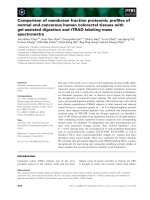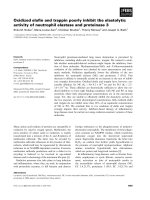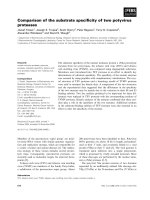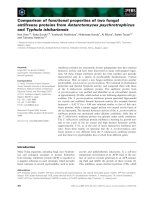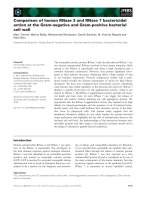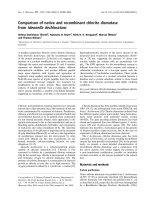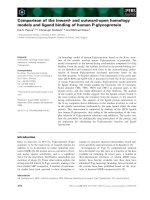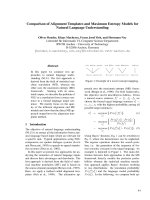báo cáo khoa học: " Comparison of hyperthermia and adrenaline to enhance the intratumoral accumulation of cisplatin in a murin model of peritoneal carcinomatosis" potx
Bạn đang xem bản rút gọn của tài liệu. Xem và tải ngay bản đầy đủ của tài liệu tại đây (341.94 KB, 8 trang )
RESEARCH Open Access
Comparison of hyperthermia and adrenaline to
enhance the intratumoral accumulation of
cisplatin in a murin model of peritoneal
carcinomatosis
Olivier Facy
1,2
, François Radais
1
, Sylvain Ladoire
1
, Delphine Delroeux
3
, Hervé Tixier
1
, François Ghiringhelli
1
,
Patrick Rat
1,2
, Bruno Chauffert
1,4
, Pablo Ortega-Deballon
1,2*
Abstract
Background: The best method to deliver intraperitoneal chemotherapy (IPC) for peritoneal carcinomatosis from
ovarian cancer is not well defined. The aim of this study was to assess the ability of hyperthermia and adrenaline
to enhance the intratumoral accumulation of cisplatin in a rat model of peritoneal carcinomatosis.
Methods: Four groups of 5 BDIX rats with ovarian peritoneal carcinomatosis underwent IPC with 30 mg/l of
cisplatin according to the following conditions: normothermia at 37° for 1 or 2 hours, hyperthermia at 42°C for 1
hour or normothermia at 37°C for 2 hours with 2 mg/l adrenaline. Tissue platinum content was measured by
atomic absorption spectroscopy. The effect of hyperthermia, adrenaline and the duration of exposure to the drug
was measured in vivo (tissue concentration of platinum in tumor, abdominal and extra abdominal tissues) and in
vitro (cytotoxicity on human ovarian cancer cells).
Results: In vitro, hyperthermia and longer exposure enhanced the accumulation and the cytotoxic effect of
cisplatin on cancer cells. In vivo, only the 2 hours treatment with adrenaline resulted in increased platinum
concentrations. The rats treated with adrenaline showed significantly lower concentrations of cisplatin in extra
peritoneal tissues than those treated with hyperthermia.
Conclusion: Adrenaline is more effective than hyperthermia in order to enhance the intratumoral concentration of
cisplatin in rats with peritoneal carcinomatosis from ovarian origin. It may also decrease the systemic absorption of
the drug.
Introduction
Despite recent improvements, the prognosis of patients
with peritoneal carcinomatosis from digestive or ovarian
origin treated with systemic chemotherapy remain s poor
[1,2]. Intraperitoneal chemotherapy (IPC) improves the
control of regional disease in ovarian cancer and
increases survival in ca rcinomatosis of colorectal origin
[3,4]. Trials have shown a surviv al benefit with post-
operative IPC versus intravenous administration of cis-
platin-based chemotherapy in ovarian cancer [5,6]. How-
ever, post-operative IPC showed poor tolerance and
reduced quality of life in comparison with stand ard sys-
temic chemotherapy [6]. Intraoperative IPC after cytore-
ductive surgery is a widely used alternative which
achieves good results [7-9]. However, the best method
for IPC has not yet been determined [10,11]. Heated
intraperitoneal chemotherapy (HIPEC) with moderate
hyperthermia (41°C to 43°C) is a potentially curative
approach for peritoneal carcinomatosis [4]. Very
encouraging results have been recently obtained with
HIPEC using oxaliplatin at 43°C for 30 minutes in
selected patients with carcinomatosis from colorectal
origin [9]. As cisplatin is currently the most active sys-
temic drug against ovarian carcinoma, it has also been
used for HIPEC [12-16]. This technique is feasible, but
* Correspondence:
1
INSERM 866, Equipe Avenir, Dijon, France
Full list of author information is available at the end of the article
Facy et al. Journal of Experimental & Clinical Cancer Research 2011, 30:4
/>© 2011 Facy et al; licensee BioMed Central Ltd. This is an Open Access article distributed under th e terms of the Creat ive Commons
Attribution License (http://creati vecommons.org/licenses/by/2.0), which permits unrestricted use , distribution, and reproduction in
any medium, provid ed the original wor k is properly cited.
somewhat toxic, and most people limit HIPEC with cis-
platin to 1 hour at 42°C or 43°C. No randomized studies
have compared heated with non-heated intraperitoneal
cisplatin in ovarian carcinoma.
In previous papers, we reported that intraperitoneal
adrenaline increased platinum uptake in rat peritoneal
tumor nodules by a factor of 2 to 3 [17-19]. Adrenaline
acts through vasoconstriction by limit ing drug w ash out
from the peritoneal cavity. Animals treated with intra-
peritoneal cisplatin and adrenaline were definitiv ely
cured, whereas those treated with intraperitoneal cispla-
tin alone had only a delay in tumo r growth [18] . In two
phase I studies, intraperitoneal cisplatin with adrenaline
was feasible in patients with refractory peritoneal carci-
nomatosis. We also established the maximal tolerated
concentration of adrenaline (2 mg/l) in combination
with 30 mg/l of cisplatin in two successive 1-hour peri-
toneal baths at 37°C a fter complete cytoreductive sur-
gery [20,21]. However, the ability of hyperthermia and
adrenaline to enhance the effect of cisplatin has never
been compared. This was the aim of this experimental
preclinical comparative study conducted in a rat m odel
of peritoneal carcinomatosis.
Methods
Animals
Female inbred BDIX strain rats, 3 months old, weighing
200-250 g, were bred in constant conditions of tempera-
ture, hygrometry and ex posure to artificial light. Experi-
mental protocols followed the “ Guidelines on the
protection of experimental animals” published by the
Council of the European Community (1986). The Bur-
gundy’ s University Animal Care and Use Committee
approved all of the procedures.
Cancer cells and tumor model
A previously described rat model of peritoneal carcino-
matosis was used. We previousl y reported the likeness of
this rat model to human ovarian carcinomatosis in terms
of peritoneal extension and chemo sensitivity to cisplatin
[22]. The DHD/K12/TRb cell line originated from a
dimethylhydrazine-induced colonic carcinoma in B DIX
rats (ECACC N° 90062901). Its PROb clone was selected
for its regular tumorigenicity when inj ected into syngenic
rats [23]. PROb cells were maintained in Ham’sF10cul-
ture medium supplemented with 10% fetal bovine serum.
SKOV-3 (HTB-77) and OVCAR-3 (HTB-161) human
ovarian carcinoma cells originate d from ATCC (Mana-
ssas, VA). IGROV-1 human ovarian carcinoma cells were
a courtesy from Jean Benard, MD (Institut Gustave
Roussy, Villejuif, France). The human ovarian cells were
cultured in RPMI medium with 10% fetal bovine serum.
The cells were detached from the culture flask using
trypsin and EDTA and centrifuged in the presence of
complete culture medium with fetal bovine serum to
inhibit trypsin. The PROb cells were suspended in 3 ml
of serum-free Ham’s F10 medium and then injected into
the peritoneum of anesthetized rats (2 × 10
6
cells in
each rat). The size of the peritoneal tumor nodules
depended upon time.
In vitro drug cytotoxicity assay
The PROb rat colon cancer cell line and the three
human ovarian cancer cell lines (SKOV-3, OVCAR-3,
and IGROV-1) were incubated in vitro with 30 mg/l cis-
platin at 42°C for 1 hour, 37°C for 2 hours (in the pre-
sence or not of 2 mg/l adrenaline), or 37°C for 1 hour
(control cells).
In vitro cytotoxicity of cisplatin on cancer cells was
determined using a quantitative clonogenic assay. Cells
(5 × 10
4
/well) were seeded and cultivated in 96-well tis-
sue culture plates for 72 hours until confluence. Cell
incubation with cisplatin was performed in serum-free
Ham culture medium at 37°C or 42°C. After rinsing, the
cells were trypsinized and seeded again in 24-well tissue
culture plates. After 6 days of culture, the cells were
washed with phosphate buffered saline, fixed with pure
ethanol for 10 min, and then stained with 1% crystal
violet in distilled water. After flushing the excess dye
with water, the r emaining dye was eluted with 33%
acetic acid. The optical density (OD) was read on an
automatic photometer at a wavelength of 540 nm. Cell
survival was determined as the ratio of OD in treated
wells to OD in control wells × 100. Experiments were
done twice in triplicate.
Treatment of animals
The rats were treated 21 days after intraperitoneal cell
inoculation. Laparotomy was performed in anaesthetized
rats (isoflurane inhalation as induction and then 100
mg/kg of intramuscular ketamine and 15 mg xylazine
into the back leg for maintenance) to check the pre-
sence of a peritoneal carcinomatosis (present in 95% of
animals). At day 21 after cell injection, the tumor
nodules were confluent in the epiploic area and
extended partly to the peritoneum wall, including
nodules in the area of the diaphragm. The abdomen was
then closed in such a way as to make it watertight.
Twenty rats were distributed into 4 groups of treatment
(5 rats per group), which are presented in Table 1.
The first group(control group) received 30 mg/l of
intraperitoneal cisplatin (Sigma-Aldrich, L’Isle d’Abeau,
France) in 50 ml of saline solution (9 g/l NaCl) at 37°C.
The second groupreceived HIPEC for 1 hour at 42°C
with 30 mg/l of cisplatin. After laparotomy, an electro-
nic thermal probe was placed in the epiploic area, an
inward catheter above the right liver, and an outward
catheter in the left splenic area. After watertight
Facy et al. Journal of Experimental & Clinical Cancer Research 2011, 30:4
/>Page 2 of 8
abdomen closure, a closed circuit was established by an
electric pump (Abbott-Gemstar, Crestline Medical, Plea-
sant Grove, UT, USA) at a flow rate of 15 ml/min.
Total volume of the circuit was 500 ml of saline solution
which was pre-heated to 37°C. Starting time was defined
as the moment the temperature reached 41.5°C and 30
mg/l cisplatin was added. The temperature was kept
constant at 42°C for 1 hour in the peritoneal cavity by
immersing an intermediate reservoir and about 1 meter
of the circuit tubing i n a t hermostat-regu lated bath at
an average temperature of 48°C. The third grouphad a
2 hours treatment with 30 mg/l of cisplatin and 2 mg/l
of intraperitoneal adrenaline: after 1 hour the abdomen
was open to empty the peritoneal cavity and a second
identical bath was then performed for 1 additional hour.
A previous experiment showed that 1 hour of treatment
with 2 mg/ml adrenaline at 37°C did not increase the
platinum content in peritoneal nodules and, thus, such a
group was not plan ned in this study (unpublished data).
The fourth groupunderwent the same treatment as the
third group, but without adrenaline. All animals from
the 4 groups were kept anesthetized, lying on the b ack,
for the entire duration of the treatment, using repeated
IM ketamine and xylazine injections as necessary.
At the end of treatment, the rats were sacrificed; the
abdominal cavity was opened and abundantly washed
with water. Epiploic tumor nodules (200 mg), the left
diaphragm, a piece of the muscle lining the abdominal
cavity measuring 5 × 5 × 1 mm thick, parietal thoracic
muscle (200 mg) in order to reflect the extra-abdominal
tissues, half of the left kidney, and about 200 mg of the
anterior edge of the liver were sampled and kept at -80°
C until the platinum assay.
The comparison of g roups 1 and 2 should assess the
effect of hyperthermia; that of groups 3 and 4 should
ass ess the effect of a drenaline; and that of groups 1 and
4 should assess the effect of the duration of IPC. A 2-
hour HIPEC was impossible due to intolerance of the
animals.
Atomic absorption spectrometry
The total concen tration of platinum was measured by
atomic absorption spectrometry (AAS). Cultured cells
were washed twice after cisplatin incubation, then tryp-
sinised and counted. Cell pellets were frozen at - 80°C
until AAS assay. A fter weighing, the fr ozen rat tis sues
were digested in a microwave digester (MLS-1200 Mega,
Milestone, Sorisole, Italy). Platinum concentration was
measured after dilution in distilled water, using a Zee-
man atomic absorption spectrometer (Spectra-A; Varian,
Les Ulis, France). Platinum is 65.01% of the molecular
mass of cisplatin; to convert platinum concentrations
into cisplatin concentrations, the first must be multi-
plied by 1.54.
Statistical Analysis
Because of the small sample size, nonparametric tests
were used to analyze the concentrations of platinum
and the operative time. The Kruskal-Wallis test was per-
formed to detect global statistically significant differ-
ences in the extent of platinum accumulation in the
organs and tumors between the four groups. When a
sig nifi cant difference was found the Mann-Whitney test
was used for 2 × 2 comparisons between groups. A two-
tailed P value of\0.05 was considered significant for all
tests. Data collection and statistical calculations were
performed by SPSS (version 10.0) software (SPSS, Chi-
cago, IL, USA).
Results
In vitro accumulation and cytotoxicity of cisplatin on
cancer cells
A temperature of 42° C was t oxic by itself. In compari-
son with the basal level, the number of residual adher-
ent cells in the wells was reduced after 1 hour
incubation at 42°C (decrease of percentage of 18%, 43%,
51%, and 17% for the PROb, SKOV-3, OVCAR-3, and
IGROV-1, respectively). This was not the case after 2
hours of t reatment with cisplatin with or without adre-
naline at 37°C. Cellular platinum concentration was
increased by hyperthermia in all cells (Figure 1). Extend-
ing the incubation to 2 hours also increased the plati-
num content in all cell lines, but there was no influence
of adrenaline.
Sensit ivity to cisplatin depended on the cell lines (Fig-
ure2).ThemostsensitivelinewasOVCAR-3(IC50
less than 2.5 mg/l after 1 hour incubation at 37°C),
whereas the least sensitive lines were SKOV-3 and
IGROV-1 (IC 50 ranging between 5 and 10 mg/l). The
rat PROb cell line had intermediate sensitivity to cispla-
tin (IC 50 2.5 mg/l). A concentration of 30 mg/l
Table 1 Characteristics of treatment in each group of rats
Group Cisplatin Adrenaline Temperature Duration of
treatment
1 30 mg/
ml
No 37°C 1 h
(1
bis*)
30 mg/
ml
2 mg/l 37°C 1 h
2 30 mg/
ml
No 42°C 1 h
3 30 mg/
ml
2 mg/ml 37°C 2 h (twice 1 hour)
4 30 mg/
ml
No 37°C 2 h (twice 1 hour)
(*) In another experiment group 1 bis achieved the same tissue concentration
of cisplatin as group 1 (unpublished data), thus this group was not repeated
in the present study
Facy et al. Journal of Experimental & Clinical Cancer Research 2011, 30:4
/>Page 3 of 8
cisplatin was found to be almost complete cytotoxic
(≥ 90%) for all cell lines. This concentration was chosen
for the in vivo experiment s. The cell toxicity of cisplatin
was significantly enhanced by 1 hour of hyperthermia at
42°C for the resistant SKOV-3 and IGROV-1 cell lines,
but not for the sensitive OVCAR-3 and PROb cells. Cis-
platin cytotoxicity was also enhanced by extending the
incubation time to 2 hours; the improvement in cyto-
toxicity was of the same order as that achieved by 1
hour of hyperthermia.
Platinum accumulation in rat peritoneal nodules and
organs
In the hyperthermia group, the closed circuit made it
possible to reach a stable intra-abdominal temperature
(42.1°C ± 0.46°C) in a mean time of 15.5 minutes (range
4-21 minutes) with variations of less than 0.5°C along
the procedure. Temperature was dependent on the flow
rate and was unstable at a flow of less than 15 ml/min.
Tolerance to HIPEC was poor. Only 3 out of 5 rats
survived until the end of the experiment. The others
presented an abnormal respiratory rhythm at about 45
minutes and died before the end. This precluded the
performance of a 2-hour HIPEC. In contrast, all of the
animals that were treated at 37°C, for either 1 or 2
hours, with or without adrenaline, were alive and well at
the end of the experiment.
Platinum concentrations in rat organs and peritoneal
nodules were measured according to the different
treatments (Figure 3). Regarding the platinum content
in peritoneal nodules, the difference between group 1
(control, 1 hour IPC), and groups 4 (2 hours IPC ) or 2
(HIPEC) did not reach significance (p = 0.06 and 0.19,
respectively). In contrast, a 3-fold increase in tumor pla-
tinum content was found in group 3 (adrenaline) as
compared to groups 1 (control, p = 0.005) and 2
(HIPEC, p = 0.005). Platinum concentration in the
abdominal muscle lining the peritoneal cavity was also
significantly greater in group 3 (adrenaline) as compared
to group 4 (HIPEC) (p = 0.006), but did not reach sig-
nificance in the diaphragm (p = 0.08).
Out of the peritoneal cavity (kidney and thoracic mus-
cle), the accumu lation of platinum was lower in group 3
(adrenaline) than in groups 1 (control) and 4 (HIPEC)
(p = 0.05 and p = 0.001, for the kidney and the thoracic
muscle, respectively).
Discussion
The present study reports the greater uptake of plati-
num in peritoneal nodules a nd in peritoneum lining
muscle when adrenaline was used in combination with
cisplatin, as compared to HIPEC. This underlines the
interest of adrenaline to increase the tissue concentra-
tion of chemotherapy and the fact that the best method
to deliver of IPC remains to be defined [10,17,21].
The rats treated with adrenaline (group 3) received
this treatment for 2 hours, as compared to those under-
going HIPEC (group 2) during only 1 hour. A 1-hour
0
5
10
15
20
25
30
35
PR
OS
K
O
VI
G
R
O
V
O
V
C
AR
Platinum (μg/million cells)
a b c d
a b c d
a b c d
a b c d
Figure 1 In vitro platinum accumulation in cancer cells. Cells (1 × 10
6
/well) were seeded in 12-well culture plates for 72 hours then
incubated with 30 mg/l cisplatin in serum-free Ham medium. Incubation conditions were: 1 hour at 37°C (a), 1 hour at 42°C (b), and 2 hours at
37°C without (c) or with (d) 2 mg/l adrenaline. Mean and SD of 3 determinations are represented.
Facy et al. Journal of Experimental & Clinical Cancer Research 2011, 30:4
/>Page 4 of 8
adrenaline group was not performed because a previous
unpublished experiment found no significant difference
after this treatment as compared to the control group.
A 2-hour HIPEC was impossible due to intolerance of
the animals to such a procedure. It could be argued that
the longer exposure explains the higher tissue uptake of
cisplatin. However, group 4 had a 2 hours IPC and did
not achieved significantly better concentrations than
group 1 (1 hour IPC); the difference was close to signifi-
cance (p = 0.06), but it can not explain a 3-fold increase
PR
O
b
S
K
O
V-3
Cisplatin (mg/L) Cisplatin (mg/L)
IGROV-1 OVCAR-3
Cis
p
latin (m
g
/L) Cis
p
latin (m
g
/L)
0
20
40
60
80
100
02,55 102030
0
20
40
60
80
100
02,55 102030
0
20
40
60
80
100
02,55 102030
0
20
40
60
80
100
02,55 102030
Figure 2 In vitro cytotoxicity of cisplatin. Cells (5 × 10
4
/well) were seeded in 96-well culture plates for 72 hours, then treated with cisplatin in
serum-free Ham medium. Treatment conditions were: 1 hour at 37°C (dark triangles), 1 hour at 42°C (open triangles), 2 hours at 37°C without
(dark squares) or with (clear squares) 2 mg/l adrenaline. Mean and SD of 4 determinations of cell survival (percent of control cells) are
represented.
Facy et al. Journal of Experimental & Clinical Cancer Research 2011, 30:4
/>Page 5 of 8
in concentration. The effect of time probably exists, but
is small. This is consistent with the results of a previous
pharmacokinetic study which showed that most of the
uptake happens at the beginning of IPC, when the gradi-
ent of concentrations is higher: a twice 1-hour bath (as
done in the present study) with a newly prepared identi-
cal solution was more effecti ve than a 2-hour bath [24].
Similar results have been obtained in HIPEC with oxali-
platin [11].
Adrenaline also increased the drug content in the
muscle of the abdominal wall. We obser ved a ratio of 5
to 17 in drug uptake between an abdominal muscle and
a distant thoracic muscle. This reflects the pharmacolo-
gical advantage of IPC to obtain high local drug concen-
trations in the abdominal wall, peritoneum and muscle
lining, all of which are possibly infiltrated by malignant
cells in peritoneal carcinomatosis. In previous studies
we used a higher concentration of adrenaline (5 or 10
mg/L) [18,19]. In the present study it was reduced
according to a recent phase I clinical trial, which estab-
lished the safety of 2 mg/l of adrenaline, whereas 3 mg/l
induced cardiovascular collateral effects (tachycardia,
arterial hypertension or electric signs of cardiac ische-
mia) [21].
Despite their longer exposure, rats treated with adre-
naline showed lower extraperitoneal concentrations of
platinum than both, the control and the HIPEC groups.
This is probably explained by the vasoconstrictor effect
of adrenaline which prevented the systemic diffusion,
and thus, the potential toxicity of cisplatin. At the oppo-
site, HIPEC has been shown to increase systemic
absorption of chemotherapy drugs due to heat-induced
vasodilatation [11].
Our results confirmed the well-known enhancing
effect of hyperthermia on the platinum uptake, as well
in vitro as in vivo [25-28]. In vitro , the thermal
enhanced ratio (TER) after 1 hour exposure at 42°C
compa red to 37°C ranged from 1.5 to 2.1, depending on
the cell line. The TER was lower than that found in
other studies (3.4 for 1 hour at 43°C in a different colon
cancer cell line in rats; 2.2 or 3.9 for hamster kidney
cells and Chinese hamster fibroblasts, respectively)
[26,27]. The reasons for these discrepancies (technical
var iations or true differences in membrane permeability
in different cell lines) are unknown. The increased accu-
mulation due to extending exposure to 2 hours (1 .6 to
2.5) was of the sa me order as the TER recorded after 1
hour. Temperature is mainly thought to accelerate the
passive diffusion of cisplatin by disturbing the phospho-
lipid bilayer arrangement, even if other mechanisms,
such as a direct apoptotic or necrotic effect, may be
involved in cell death.
In vitro experiments on cancer cell lines alone cannot
predict the in vivo effect of temperature or adrenaline.
Tumor tissue penetration is the limiting factor for the
activity of the chemotherapeutic agents [29]. It has been
0
5
10
15
20
25
30
Platinum (μg/g of tissue)
*
*
TUMOR DIAPHR ABD/MU KIDNEY LIVER THOR/MU
a b c d
a bc d
a b c d
a b cd
a bc d
Figure 3 In vivo accumulation of platinum in peritoneal tumor and organs. Intraperitoneal chemotherapy was performed using 30 mg/l of
cisplatin. Tumor and organs were sampled: after 1 hour cisplatin at 37°C (a), after 1 hour cisplatin at 42°C (b), after 2 hours cisplatin with (c) or
without (d) 2 mg/l adrenaline. Mean and SD of 5 animals. Asterisk indicates a statistical difference (p < 0.01) between the 2 hours treatment at
37°C with 2 mg/L adrenaline, and the 1 hour treatment at 42°C. ABD/MU = abdominal muscle and THOR/MU = thoracic muscle.
Facy et al. Journal of Experimental & Clinical Cancer Research 2011, 30:4
/>Page 6 of 8
hypothesized that the depth of penetration of cisplatin
could be increase d by hyperthermia through its effects
on convection and diffusion in tissues, increasing cell
uptake of the drug, tumor blood flow and vascular per-
meability. Despite the clinical development of HIPEC
with platinum compounds, only a few studies have been
done in or der to establish the basis of this technique.
Two contradictory studies have been reported in rat
models of peritoneal carcinomatosis [27,30,31]. Differ-
ences in the hyperthermia technique could explain this
discrepancy. Los et al. immersed the whole animal in a
thermostatical ly controll ed water bath, resulting in
whole-body hyperthermia rather than locoregional
hypert hermia [27]. This could have modified both blood
concentrations and vascular permeability, and may
explain why plasmatic cisplatin was about 3 times
greater at 41°5 than at 3 8°C and why platinum content
was about twice as great in all organs, including the
extra-abdominal organs such as the lung. Our technique
allowed us to heat only the abdominal cavity. Using this
method of heating, a 1-hour HIPEC at 42°C did not
increase platinum content in the peritoneal tumor
nodules or in the peritoneal wall lining. Abdominal
hyperthermia was poorly tolerated by the animals; some-
times it was even necessary to stop the procedure before
60 minutes. This poor tolerance made it impossible to
compare the two methods in terms of survival. Our
negative results on HIPEC with cisplatin are consistent
with those obtained by other authors using similar
methods [31,32]. An explanation of this negative result
could be the temperature-related increase in blood flow
through the peritoneal nodules and the peritoneum due
to local vasodilatation and resulting in an increase in
the wash out of the cisplatin [33].
In contrast with heat, adrenaline at a concentration of
2 mg/l for 2 hour achieved a 2 to 3-fold increase in pla-
tinum content in the peritoneal tumor nodules. Such an
increase boosts the cytotoxic effect of cisplatin in vitro
(Figure 2). Previous rat experiments have shown us that
2 hours of IPC are required to observe the enhancing
effect of adrenaline [17,19], and our following clinical
trials have taken into account this parameter [20,21].
Experimental data show that adrenaline is more effec-
tive and better tolerated than hyperthermia in order to
enhance the penetration of cisplatin. It also minimizes
the systemic ab sorption of cisplatin. Hyperthermia was
not well tolerated in this rat model, but it is in humans.
Future clinical trials performing IPC with cisplatin for
ovarian carcinoma should compare the effectiveness of
adrenaline and hyperthermia in order to improve the
effect of intraperitoneal chemotherapy.
The authors declare that they have no competing
interests.
Acknowledgements
This paper was supported by grants from the French National League
against Cancer (Committees of Saône et Loire, Nièvre, and Côte d’Or). We
thank Philip Bastable for the help in revising the manuscript.
We thank Pierre-Emmanuel Puig Ph.D., Laurent Benoit M.D., Sylvain Causeret
M.D. and Bernard Royer M.D., Ph.D. for their help with the experiments and
their suggestions. We also thank Jean Luc Beltramo Ph.D. for the platinum
assays.
Author details
1
INSERM 866, Equipe Avenir, Dijon, France.
2
Department of Digestive Surgical
Oncology, University Hospital of Dijon, France.
3
Department of Digestive
Surgery, University Hospital of Besançon, France.
4
Department of Medical
Oncology, University Hospital of Amiens, France.
Authors’ contributions
OF, FR and DD carried out the in vivo experiments. SL and HT carried out
the in vitro experiments. BC participated in the design of the study and
performed the statistical analysis. POD, FG and PR conceived the study, and
participated in its design and coordination. All authors read and approved
the final manuscript.
Received: 2 December 2010 Accepted: 7 January 2011
Published: 7 January 2011
References
1. Gadducci A, Cosio S, Conte PF, Genazzani AR: Consolidation and
maintenance treatments for patients with advanced epithelial ovarian
cancer in complete response after first-line chemotherapy: a review of
the literature. Crit Rev Oncol Hematol 2005, 55:153-66.
2. Jayne DG, Fook S, Loi C, Seow-Choen F: Peritoneal carcinomatosis from
colorectal cancer. Br J Surg 2002, 89:1545-50.
3. Fujiwara K, Armstrong D, Morgan M, Markman M: Principles and practice
of intraperitoneal chemotherapy for ovarian cancer. Int J Gynecol Cancer
2007, 17:1-20.
4. Verwaal VJ, Bruin S, Boot H, van Slooten G, van Tinteren H: 8-Year follow-
up of randomized trial: cytoreduction and hyperthermic intraperitoneal
chemotherapy versus systemic chemotherapy in patients with
peritoneal carcinomatosis of colorectal cancer. Ann Surg Oncol 2009,
15:2426-32.
5. Armstrong DK, Bundy B, Wenzel L, Huang HQ, Baergen R, Lele S, et al:
Intraperitoneal cisplatin and paclitaxel in ovarian cancer. N Engl J Med
2006, 354:34-43.
6. Fung-Kee-Fung M, Provencher D, Rosen B, Hoskins P, Rambout L, Oliver T,
et al: Intraperitoneal chemotherapy for patients with advanced ovarian
cancer: a review of the evidence and standards for the delivery of care.
Gynecol Oncol 2007, 105:747-56.
7. Bankhead C: Intraperitoneal therapy for advanced ovarian cancer: will it
become standard care? J Natl Cancer Inst 2006, 98:510-2.
8. Yan TD, Stuart OA, Yoo D, Sugarbaker PH: Perioperative intraperitoneal
chemotherapy for peritoneal surface malignancy. J Transl Med 2006, 4:17.
9. Elias D, Lefevre JH, Chevalier J, et al: Complete cytoreductive surgery plus
intraperitoneal chemohyperthermia with oxaliplatin for peritoneal
carcinomatosis of colorectal origin. J Clin Oncol 2009, 27:681-5.
10. Esquivel J: Technology of hyperthermic intraperitoneal chemotherapy in
the United States, Europe, China, Japan, and Korea. Cancer J 2009,
15:249-54.
11. Ortega-Deballon P, Facy O, Jambet S, Magnin G, Cotte E, Beltramo JL, et al:
Which method to deliver heated intraperitoneal chemotherapy with
oxaliplatin? An experimental comparison of open and closed
techniques. Ann Surg Oncol 2010, 17:1957-63.
12. Cotte E, Glehen O, Mohamed F, Lamy F, Falandry C, Golfier F, et al:
Cytoreductive surgery and intraperitoneal chemo-hyperthermia for
chemo-resistant and recurrent advanced epithelial ovarian cancer:
prospective study of 81 patients. World J Surg 2007, 31:1813-20.
13. Helm CW, Randall-Whitis L, Martin RS, Metzinger DS, Gordinier ME,
Parker LP, et al: Hyperthermic intraperitoneal chemotherapy in
conjunction with surgery for the treatment of recurrent ovarian
carcinoma. Gynecol Oncol 2007,
105:90-6.
14.
Kusamura S, Younan R, Baratti D, Costanzo P, Favaro M, Gavazzi C, et al:
Cytoreductive surgery followed by intraperitoneal hyperthermic
Facy et al. Journal of Experimental & Clinical Cancer Research 2011, 30:4
/>Page 7 of 8
perfusion: analysis of morbidity and mortality in 209 peritoneal surface
malignancies treated with closed abdomen technique. Cancer 2006,
106:1144-53.
15. Piso P, Dahlke MH, Loss M, Schlitt HJ: Cytoreductive surgery and
hyperthermic intraperitoneal chemotherapy in peritoneal carcinomatosis
from ovarian cancer. World J Surg Oncol 2004, 2:21.
16. Raspagliesi F, Kusamura S, Campos Torres JC, de Souza GA, Ditto A,
Zanaboni F, et al: Cytoreduction combined with intraperitoneal
hyperthermic perfusion chemotherapy in advanced/recurrent ovarian
cancer patients: The experience of National Cancer Institute of Milan. Eur
J Surg Oncol 2006, 32:671-5.
17. Chauffert B, Favoulet P, Polycarpe E, Duvillard C, Beltramo JL, Bichat F, et al:
Rationale supporting the use of vasoconstrictors for intraperitoneal
chemotherapy with platinum derivatives. Surg Oncol Clin N Am 2003,
12:835-48.
18. Duvillard C, Benoit L, Moretto P, Beltramo JL, Brunet-Lecomte P, Correia M,
et al: Adrenaline enhances penetration and anti-cancer activity of local
cisplatin on rat sub-cutaneous and peritoneal tumors. Int J Cancer 1999,
81:779-84.
19. Favoulet P, Magnin G, Guilland JC, Beltramo JL, Osmak L, Benoit L, et al:
Pre-clinical study of the adrenaline-cisplatin association for the
treatment of intraperitoneal carcinomatosis. Eur J Surg Oncol 2001,
27:59-64.
20. Molucon-Chabrot C, Isambert N, Benoit L, Zanetta S, Fraisse J, Guilland JC,
et al: Feasibility of using intraperitoneal adrenaline and cisplatin in
patients with advanced peritoneal carcinomatosis. Anticancer Drugs 2006,
17:1211-7.
21. Guardiola E, Chauffert B, Delroeux D, et al: Intraoperative intraperitoneal
(IP) chemotherapy with cisplatin and epinephrine after cytoreductive
surgery in patients with recurrent ovarian cancer: a phase I study.
Anticancer Drugs 2010, 21:320-5.
22. Chauffert B, Dimanche-Boitrel MT, Genne P, Petit JM, Onier N, Jeannin JF:
Experimental chemotherapy of peritoneal carcinomatosis of colonic
origin in rats. Gastroenterol Clin Biol 1992, 16:215-9.
23. Martin F, Caignard A, Jeannin JF, et al: Selection by trypsin of two
sublines of rat colon cancer cells forming progressive or regressive
tumors. Int J Cancer 1983, 32:623-7.
24. Royer B, Delroeux D, Guardiola E, Combe M, Hoizey G, Montange D, et al:
Improvement in intraperitoneal intraoperative cisplatin exposure based
on pharmacokinetic analysis in patients with ovarian cancer. Cancer
Chemother Pharmacol 2008, 61:415-21.
25. Barlogie B, Corry PM, Drewinko B: In vitro thermochemotherapy of human
colon cancer cells with cis-dichlorodiammineplatinum (II) and mitomycin
C. Cancer Res 1980, 40:1165-8.
26. Eichholtz-Wirth H, Hietel B:
Heat sensitization to cisplatin in two cell lines
with different drug sensitivities. Int J Hyperthermia 1990, 6:47-55.
27. Los G, Sminia P, Wondergem J, Mutsaers PH, Havemen J, ten Bokkel HD,
et al: Optimisation of intraperitoneal cisplatin therapy with regional
hyperthermia in rats. Eur J Cancer 1991, 27:472-7.
28. Meyn RE, Corry PM, Fletcher SE, Demetriades M: Thermal enhancement of
DNA damage in mammalian cells treated with cis-
diamminedichloroplatinum (II). Cancer Res 1980, 40:1136-9.
29. Conti M, De GU, Tazzari V, Bezzi F, Baccini C: Clinical pharmacology of
intraperitoneal cisplatin-based chemotherapy. J Chemother 2004,
16(Suppl 5):23-5.
30. Los G, van Vugt MJ, Pinedo HM: Response of peritoneal solid tumours
after intraperitoneal chemohyperthermia treatment with cisplatin or
carboplatin. Br J Cancer 1994, 69:235-41.
31. Zeamari S, Floot B, van d, Stewart FA: Pharmacokinetics and
pharmacodynamics of cisplatin after intraoperative hyperthermic
intraperitoneal chemoperfusion (HIPEC). Anticancer Res 2003, 23:1643-8.
32. El-Kareh AW, Secomb TW: A theoretical model for intraperitoneal delivery
of cisplatin and the effect of hyperthermia on drug penetration
distance. Neoplasia 2004, 6:117-27.
33. Ausmus PL, Wilke AV, Frazier DL: Effects of hyperthermia on blood flow
and cis-diamminedichloroplatinum (II) pharmacokinetics in murine
mammary adenocarcinomas. Cancer Res 1992, 52:4965-8.
doi:10.1186/1756-9966-30-4
Cite this article as: Facy et al.: Comparison of hyperthermia and
adrenaline to enhance the intratumoral accumulation of cisplatin in a
murin model of peritoneal carcinomatosis. Journal of Experimental &
Clinical Cancer Research 2011 30:4.
Submit your next manuscript to BioMed Central
and take full advantage of:
• Convenient online submission
• Thorough peer review
• No space constraints or color figure charges
• Immediate publication on acceptance
• Inclusion in PubMed, CAS, Scopus and Google Scholar
• Research which is freely available for redistribution
Submit your manuscript at
www.biomedcentral.com/submit
Facy et al. Journal of Experimental & Clinical Cancer Research 2011, 30:4
/>Page 8 of 8
